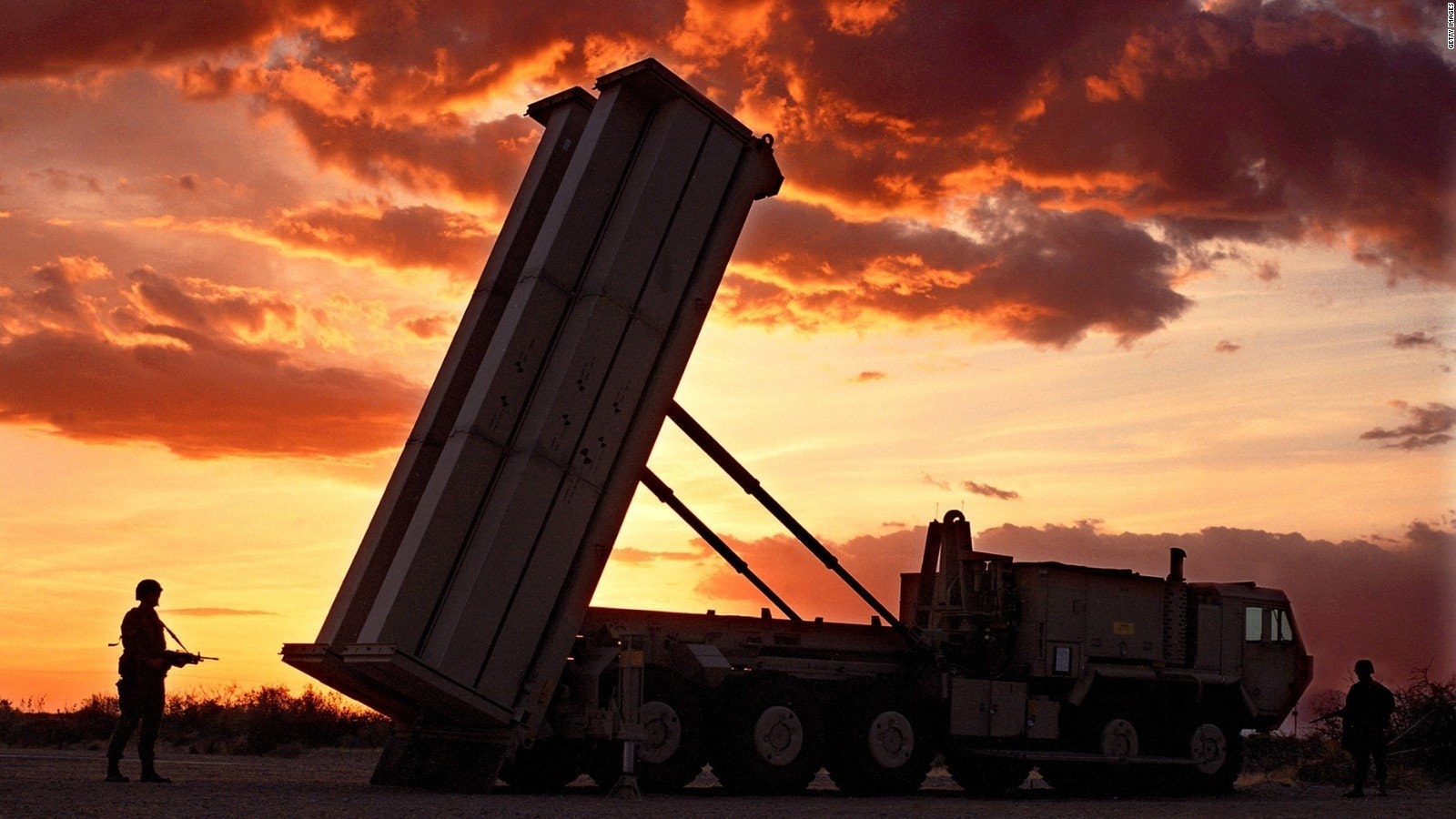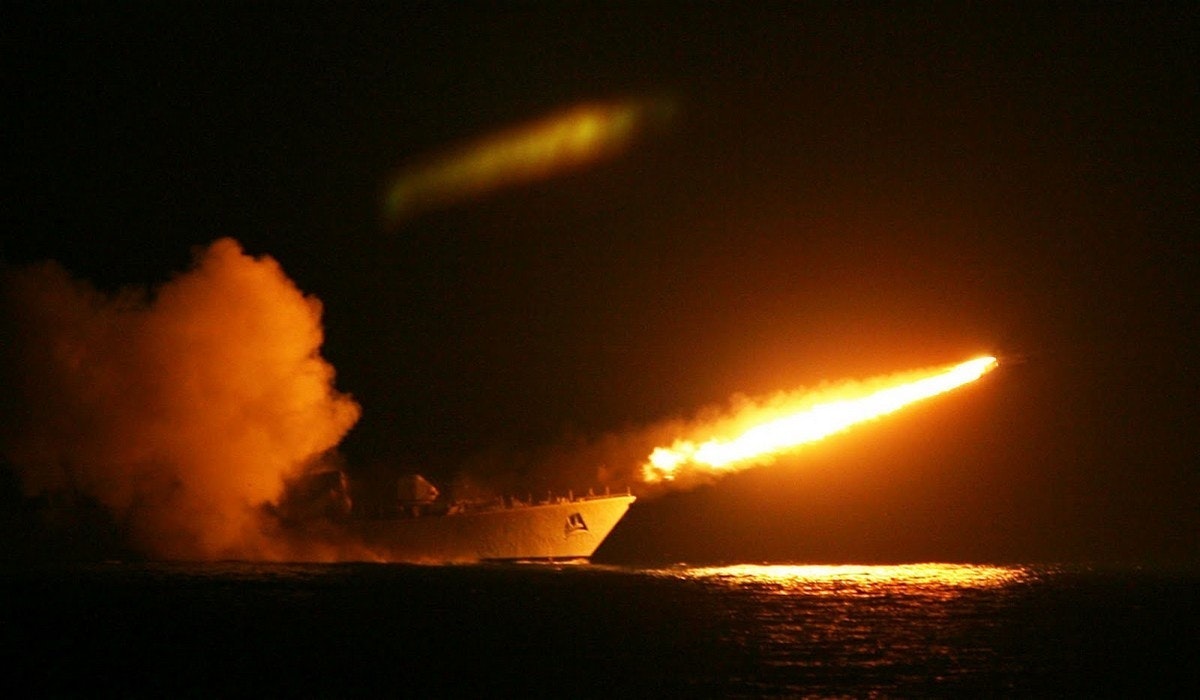Are we living in the age of relative peace? Should we prepare for conventional war?
This article was submitted to the UK Defence Journal by Matthew R. Doherty. Matthew is a graduate of the Universities of Leeds and Edinburgh. He specialises in military studies, with an emphasis on counterinsurgency operations.
THAAD stands for Terminal High Altitude Area Defense and is an American weapon system designed to intercept and shoot down short, medium and intermediate range ballistic missiles before they can strike their targets.
The development of this system (and others like it) could herald a new phase in warfare. The concept of an anti-missile defence goes back many decades. However, unlike Reagan’s Star Wars, which literally never got off the ground, this system is proven, suitable for mass-production, and is operational in many countries today.

Since the development and large scale building of nuclear weapons during the 1940’s and 50’s, the superpowers of the world have not dared risk a global confrontation of conventional armies – for fear of the rapid annihilation and dispersal of their forces through nuclear strikes. In short, as with the longbow to plate armour, or the machine gun to massed infantry, the offense has overtaken the personal defence.
The sheer destructive potential of nuclear weapons has, for this long, so outstripped any potential defence that even the thought of pursuing large-scale war between the superpowers is anathema to most sane politicians. Of course, proxy wars have been fought from Vietnam to Angola, but we have not yet seen repeats of Kursk, Stalingrad or the Bulge.
But what if the defence is steadily catching up? Could anti-missile systems, or systems in orbit, effectively shoot down all nuclear and non-nuclear ballistic missiles deployed against a conventional unit? Could THAAD, and later improved systems, be adapted to screen such units in conventional operations? Perhaps one day, mobile anti-missile launchers will be as crucial a part of an armoured division as its Main Battle Tank? However unlikely such an eventuality is, military planners looking at long-term projections must at least allow for the possibility.

Despite the intentions of the CND, the Pandora’s Box of nuclear weaponry will probably never be shut. If missiles were prevented from being the main method of deployment, there are other options, all with drawbacks. Planes can be used to carry nukes, but planes can be shot down easier than a missile. Nuclear artillery could be pressed back into use, but it would be slow moving, difficult to deploy and use effectively, and its size and slowness would mean it could be easily spotted and destroyed. Nuclear demolitions are another option – but they require careful planning and are limited in scope.
So could the defence overtake the offense to the point where large scale conventional land warfare could rear its ugly head again? The prospect of thousands of Russian tanks overrunning inadequate and underfunded NATO forces in Western Europe, or of a resurgent China taking on Russia. The prospect of India and Pakistan squaring off conventionally. These are very plausible future scenarios if the threat of nuclear strikes are eliminated or dramatically reduced.

For now the focus for Western armies is, understandably, on counterinsurgency and asymmetrical warfare. As the global population increases and the effects of climate change are felt, a score of bitterly fought Londonderry’s in the mega-cities of the developing world awaits. But what of thirty, forty or even fifty years from now? Electronic detection and scrambling will no doubt refine. AI in warfare will become ever more prevalent. Anti-missile technology will, I believe, improve in leaps and bounds.
Is the relative peace we have enjoyed since the terrible examples of Hiroshima and Nagasaki simply borrowed time? Are we gradually shifting from the era of small wars into the next confrontation the world will have with itself?













It’s a fine line?
Seems pretty wide to me. If you look back 600 years (records before that are probably a little difficult) it is difficult to find periods where large swathes of Europe weren’t fighting without even considering the rest of the world. The last 70 years has seen a period where Europe, North America and much of Asia has been relatively quiet for fear nuclear war or superpower intervention. Africa and South America maybe less so.
The current status is precarious in terms of state control in certain countries where various factions are at odds, internally and in regards to offense actions. With nuclear proliferation becoming a central issue, any weapon be it a dirty device, or delivered by a missile is an increasingly dangerous prospect.
Also, certain rogue states have a black and white policy in terms of military plans and these, though mainly subterranean, are nevertheless dangerous situations.
If you want peace, prepare for war.
A country should always keep its armed forces strong and resourced.
It is no different to keeping locks on your doors and windows as there are thieves out there, I cannot understand unilateral disarmament types who don’t get that.
The arms race between offensive versus defensive technologies has been going on forever, and has resulted in ever more powerful (and more recently- selectively targetable) offensive systems, squaring off against ever more effective defensive systems. However, the essential fragility of human physiology remains a constant, which must factor into strategic calculations.
e.g. my mediaeval army’s armour protection can defend the force against 99% of the hail of arrows and rocks they’re facing. My army will not take significant casualties.
Now- my modern army’s missile defence system can defend against 99% of the hail of 200 kt thermonuclear warheads they’re facing. The 1% still obliterates everything I wanted to protect.
Not really the blast radius for 200kt is 7 kilometers surface and 11 kilometers airburst (note the effect of radiation is dependent on weather and provenance of the warhead and where it detonated). A modern engagement can take place over hundreds of kilometers.
The damage of Nuclear weapons could individually inflict has always been overplayed and dramatized. They are not a big kill everything button (see the continued habitation of Hiroshima and Nagasaki). All that has significantly changed by going from 20kt to 200kt is going from a 4.5km radius to a 11km radius. In other words not particularly useful when you have to saturate defenses.
Wasn’t that one of the reasons behind multiple independent re-entry vehicles. For example, 100 missiles deploying eight warheads each saturates defences and increases targeted kill areas.
The problem with THAAD is that it must destroy the missile in the boost phase before the MIRVs deploy, which is fine for short to intermediate range missiles. The long range intercontinental launch requires early warning satellite surveillance, but these satellites fly a predictable path so can be avoided or destroyed. Also you can launch the ICBM on a parabola over you own country deploying the MIRVs as soon as they get to orbit, requiring an anti-missile defence to engage over the other’s country.
The real goal of anti “nuclear” missile defence is countering the MIRVs, which could be done using hypersonic rail gun rounds. The problem being tracking the MIRV, but also requiring the railgun’s (rails) durability to significantly increase as well as the rate of fire. By today’s standard will need to be an absolute beast of a weapon.
The Longbow being able to defeat plate armour is a myth I’m afraid. Last weekend I was at the Chalke Valley History Festival and a guy there has spent the last few years recreating Longbows and arrows, using the same materials and construction techniques, as those found on the Mary Rose. He has tested them against recreated armour of the time and they shattered on impact.
If you remove the blip which is the early 20c ( and treat everything that happened between 1914 and 1953 as one long conflagration of violence, like a virus that just keep spreading) we have as a species been becoming more and more peaceful as our ability to kill has increased. Up until the renaissance war was more of a constant state than peace with Feudal society effectively based around warfare. Even renaissance society was based around the everyday application of violence (if a peer insulted you, you tried to kill them).
Our ancestors were stone cold killers beyond anything we can imagine today and lived in cultures based around the everyday application of lethal force.
Even without ABM technology, strong conventional armed forces are a prerequisite for maintaining the strategic balance and peace.
The threat of mutually assured destruction means that a nuclear war is less likely to be triggered, but that does not necessarily rule out a conventional campaign.
If for instance, NATO countries were invaded by a foreign conventional force belonging to a nuclear power, the US and UK would not automatically resort to using nuclear weapons, as this would invite a nuclear reprisal on the home country.
Knowing that the US and the UK would not invite nuclear attack upon themselves by using their own nuclear arsenal to break up a conventional advance on Europe, the invading country could roll its tanks through central Europe safe in the knowledge that the US and UK would not retaliate against their advance with nuclear weapons (of course, if the invading forces invaded France, the French probably would launch an all out attack, the twitchy buggers. Guess they lack faith in their ability to defend themselves after the Maignot Line debacle).
NATO tactical nuclear weapons could potentially be used on the battlefield to stall an advance by a hostile conventional force, but such a policy would likely invite retaliation in kind, as well as increasing the overall risk of conflict escalating to such a point where nations’ strategic nuclear arsenals were deployed.
Therefore, to defend against a foreign force invading Europe with conventional weapons while avoiding recourse to full scale nuclear war, it is therefore always important to maintain strong conventional forces that can resist an invasion of Europe by a strong conventional force, and make clear that NATO’s resolve in defending all member states from aggression was strong, and any potential aggressor understood clearly that NATO as a collective had both the forces available and the commitment to resist any attack.
This is why UK deployments to the Baltic and the Black Sea are important, and why we do need to rebuild our conventional Armed Forces after the debilitating cuts of the last decade and ensure that they are at such a capability so as to deter any military aggression against our interests wherever they may be, whether that is Europe, the North Atlantic, the South Atlantic, the Middle East or in the Asia Pacific region.
So, on that note…
Dear Treasury, can we please have:
– Our full complement of Apache gunships (and another 17 or so so we are replacing like for like)
– Challenger 2 upgrade
– Some kind of decision on Warrior upgrade/replacement
– More Typhoons
– Actually purchasing the F35s you said you would
– Speed up Type 26 procurement and agree to buy 6 more to cover the last 6 Type 45s that weren’t ordered and the Batch 3 Type 22s that were retired without replacement
– Make a decision on Type 31
– Keep Albion and Bulwark
– Plan a replacement class for Albion, Bulwark and Ocean
– Commit to building FSS class in UK shipyards
– Increase our armoured units
– Increase our helicopter force
And last but by no means least..
-Increase personnel numbers to take strain off serving personnel
Not much to ask for, right??
World War 2 followed a decade after the Stock Market crash. We are now a decade on from the last global credit crash. I do not think anyone wants war, but the risk of a Summer 1914 war by accident, is very real to my mind.
Do we include for the 200m killed by their own communist governments last century?
What about the various genocides like Rawanda or Sudan?
How about starvation caused by local conflicts like Ethiopia in the 80s and what about the deaths caused by proxy wars and revolutions stirred up by mainly, though not exclusively, Western Intelligence Agencies?
In the 1600s an army rolls in to town and brutally kills rebellion in a week or two. Nowadays, we keep it off the books. We ferment rebellion, finance uprisings and supply the guns and let a slow bloody revolution change the politics over a year. Russia then walks in and annexes the situation.
In the meantime, nations, health services and companies are being held ransom by a cyber crime pandemic. Iran encroaches on Israel with 100000 troops and terrorist organisations become the freedom fighters’ vehicle of resistance.
At home we legalise debauchery and frankly anything we cannot be bothered to stop any more. Killers are out on the streets in 3 years and the Lion of Millwall who helped so many during the London Bridge attacks is put under a Prevent Order because the government think he has a chance of becoming radicalised. Knife crime is soaring in London but that’s ok because the Mayor of London and his media friends can point out that it’s worse in many US cities, as though that’s some kind of accolade and Drag Queens on the sex offenders list are invited in to libraries for children’s story times.
Meanwhile, in Hong Kong millions stand against closer political integration with mainland China, the old British flash used as a symbol of freedom while at the same time EU bureaucrats in Strasbourg congratulate themselves in turning Britain in to a colony via Brexit negotiations.
It’s peace Jim but not as we knew it.
Peace is often only relative when compared to the funeral pyres of cities.
I like that. Though I think I’d change the ‘when compared to’ to ‘until compared to’.
Though my point was we hide the death and suffering better nowadays. We subcontract it to others and hide it behind socio political changes, but it’s still there. It’s not relative in this way of thinking.
At the end of the day 7 million Ukrainians starving to death under Stalin because of enforced food exports from a net producer is a crime against humanity verging on incomprehensible, but it wasn’t violence or warfare that performed this monstrosity, it wasn’t religion but outright politics. An ideology and government wed so tightly it throttled the very life out of its people. By any measure this holocaust exceeds the funeral pyre of a city but the holodomor famines are almost unknown.